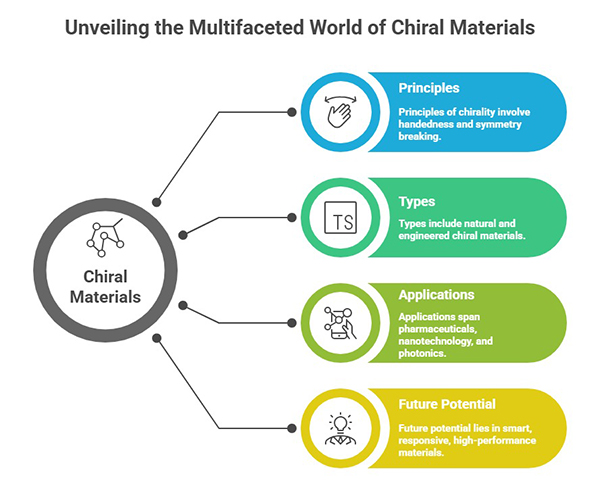

Chiral materials—those that lack mirror symmetry, much like our left and right hands—are unlocking a new dimension in science and technology. Found in nature and now increasingly engineered in laboratories, these materials exhibit unique optical, electronic, and mechanical properties that arise from their handedness. From drug delivery systems that interact selectively with biological targets to advanced sensors, metamaterials, and next-generation displays, chiral materials are at the forefront of innovation.
Their ability to rotate polarized light, interact differently with left- and right-handed molecules, and influence molecular recognition makes them indispensable in fields like pharmaceuticals, nanotechnology, photonics, and materials science. As researchers learn to design and manipulate chirality at both molecular and macroscopic levels, the possibilities for smart, responsive, and high-performance materials continue to expand.
This page explores the fascinating world of chiral materials—their principles, types, applications, and future potential—offering a gateway into a rapidly evolving field where symmetry breaks, and new opportunities begin.
“Chirality is fundamental to chemistry, molecular biology and photonics, but chirality itself is not often in the spotlight. Lewis E. MacKenzie and Patrycja Stachelek report on the 2021 Chiral Materials meeting, which explored how chirality manifests in functional materials and how it can lead to new technological applications”...
Lewis E. MacKenzie & Patrycja Stachelek
Nature Chemistry, 13, 521–522., 2021
“Chirality has been one of the core research topics in the multidisciplinary fields of materials science, chemistry, biology, medicine, and physics. The subject of chirality in nanomaterials represents one of the most dynamic areas, and it has recently emerged as a new “growth point” of nanoscience. Of particular interest, recent advances in chiral materials endow the asymmetry- breaking capability to synthesize chiral materials with tunable and reconfigurable chiroptical properties, as well as various functions and emerging applications”...
Hua Kuang,Chuanlai Xu,Zhiyong Tang
Adv. Mater. 2020, 32, 2005110
https://https://onlinelibrary.wiley.com/doi/full/10.1002/adma.202005110![]()
“Chirality is integral to biological complexity. Chiral biomolecules are central to all fundamental recognition, conformational and replication functions in biological systems. Chirality also exists in living cells and higher order biological structures. Less is known about the cellular interactions with chirality, although most living cells are imprinted with chiral-based signatures. The harnessing of molecular, supramolecular, and structural chirality has been largely overlooked in biomaterials chemistry and the engineering of biological structures for regenerative medicine”...
Mark E. Davis
ACS Catal. 2018, 8, 11, 10082–10088, 2018.
Stephen K. Brand, Joel E. Schmidt, Michael W. Deem, Frits Daeyaert, Yanhang Ma, Osamu Terasaki, Marat Orazov, and Mark E. Davis
PNAS May 16, 2017 114 (20) 5101-5106
“Separation of racemic mixtures is of great importance and interest in chemistry and pharmacology. Porous materials including metal-organic frameworks (MOFs) have been widely explored as chiral stationary phases (CSPs) in chiral resolution. However, it remains a challenge to develop new CSPs for reversed-phase high-performance liquid chromatography (RP-HPLC), which is the most popular chromatographic mode and accounts for over 90% of all separations. Here we demonstrated for the first time that highly stable Zr-based MOFs can be efficient CSPs for RP-HPLC”...